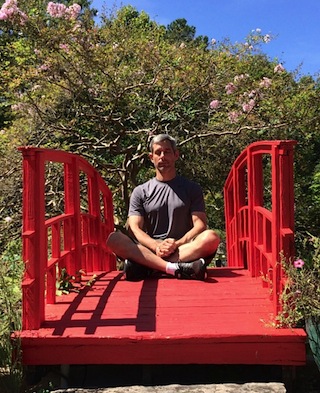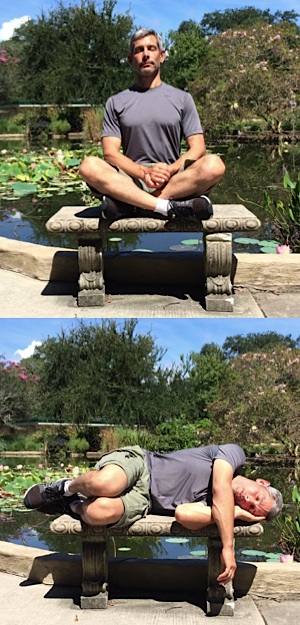Learning how to meditate can be confusing. As a martial artist, I have been exposed to more styles of meditation than I can remember. Some I found to be helpful, some bordered on insane.
My first meditation teacher, however, wasn’t a martial artist at all. He was a man by the name of René Descartes. Yes, the 17th century French mathematician and philosopher.
 You see, I was a philosophy major in college. Don’t laugh—so was Bruce Lee, Thomas Jefferson, and Martin Luther King, Jr.
You see, I was a philosophy major in college. Don’t laugh—so was Bruce Lee, Thomas Jefferson, and Martin Luther King, Jr.
In my sophomore year, we were introduced to Descartes’ book, Meditations. In that book, written almost 400 years ago, Descartes wrote what I think is the ultimate, timeless instruction for self-examination.
I liked the passage so much, I typed it up and taped it into one of my martial arts notebooks. Here’s the passage—
I will now close my eyes. I will stop my ears. I will turn away my senses from their objects. I will even efface from my consciousness all the images of corporeal things; or at least, because this can hardly be accomplished, I will consider them as empty and false; and thus, holding converse only with myself, and closely examining my nature, I will endeavor to obtain by degrees a more intimate and familiar knowledge of myself.
How cool is that? Shut out the world, shut out your ideas of the world, and rebuild your knowledge from scratch.
I was excited to discover another quote that offers the exact same instruction, but in fewer words. This advice was included in Taoist writings from over 2,300 years ago.
Author Victor Mair attributes the following quote to a disciple of Confucius named Yan Hui. Here is how Yan Hui explains his style of meditation, a method he called “sitting and forgetting”—
I slough off my limbs and trunk, dim my intelligence, depart from my form, leave knowledge behind, and become identical with the Transformational Thoroughfare.
The Transformational Thoroughfare! What a perfect metaphor. It identifies meditation as a pathway to change, which is the whole point, right? Otherwise, why would you do it?
So, if you’ve ever wanted to learn how to meditate, but found the methodology too intimidating or just plain weird, let me share three tips with you to help sift through the nonsense and get you on track.
I promise you’ll find nothing wacky or impractical here. Just three pieces of advice to keep you from crashing and burning on the Transformational Thoroughfare.
How to Meditate Without Losing Your Mind
One quick note—I’m not a doctor or guru. I’m a martial artist. That means everything I say is based on my personal experiences and not medical studies or historical surveys…
…and in my opinion, that’s the way it should be! I don’t think meditation should be approached as something complex, exotic, or foreign. I think it’s as natural as sleeping, moving, and talking. In that spirit, here’s the first tip…
TIP #1: Don’t let anyone tell you you’re doing it wrong.
Just like martial arts, meditation means different things to different people. It can also be practiced in different ways.
- You can meditate sitting, standing, or lying down.
- You can close your eyes or stare at objects.
- You can make sounds, repeat mantras, or just listen to your breath.
- Meditation can be part of a religious practice or have nothing to do with religion at all.
- You can manipulate your breathing with intricate counting systems or inspire and expire naturally.
- You can meditate at a special time of day or integrate it into every moment of your life.
Yikes! See what I mean? The number of meditation styles and methodologies out there can be overwhelming. This can lead some baffled wisdom seekers to give up on learning how to meditate altogether.
Don’t be that guy! Think of it this way…
The wide variety in approaches to meditation just proves one thing—there is no right or wrong way to meditate!
Meditation can be anything you want it to be. It’s a personal journey.
 As human beings, it’s always tempting to follow a path that has already been stamped into the ground instead of cutting your own path through the jungle. Whether it’s choosing a martial arts school, new shoes, or a cookie recipe, it’s easy to devalue your intuition and hand over authority to someone else.
As human beings, it’s always tempting to follow a path that has already been stamped into the ground instead of cutting your own path through the jungle. Whether it’s choosing a martial arts school, new shoes, or a cookie recipe, it’s easy to devalue your intuition and hand over authority to someone else.
That’s not to say there is no value in following a tradition. After all, you have to start somewhere! For that reason, I’d say there’s nothing wrong with pursuing any tradition you find appealing and giving yourself over to it whole-heartedly.
All I ask is that you be honest with yourself as you go along. Does the tradition feel right? Is it providing what you hoped to gain? If so, stick with it. If not, get out.
Over the years, I have tried many methods of meditating—
- I have kneeled, stood, and moved.
- I have woken up early and stayed up late.
- I have broken out into a sweat while sitting still.
- I have slowed my pulse and breathing rates.
- I have employed natural breathing and reverse breathing.
- I have experimented with the inner smile.
- I have imagined moving energy around the microcosmic orbit.
- I believed I was going crazy from practicing the yogic Breath of Fire improperly.
And what did I get for all of that?
Trick question! It doesn’t matter. What matters is what YOU can get out of all of that.
Here’s my advice—try any and all methods you run across. Trust yourself to feel your way through the good and the bad and the worthless. Just remember this—
Meditation is not mystical or magical—it’s natural. At its core, meditation is simply spending time with your own mind. That shouldn’t scare you. Or intimidate you. Or make you feel like an uninvited guest crashing a party.
It’s actually the other way around! The whole world and everyone in it is trying to crash your party!
Think of meditation as your doorman. Train your brain to be careful in whom and what it allows to enter into your thoughts. Once you find a method that keeps you healthy and content, do yourself a favor…
Don’t let anyone tell you you’re doing it wrong.
TIP #2: Don’t fight with your brain.
The notion that you can sit down and immediately enter into a blissful trance is absurd. Yet many people still seem to expect instant results from meditation.
I hear people say, “I tried meditating, but I can’t sit still for that long,” or “I get too distracted to meditate.”
Hey—you’re not that special! Meditating isn’t easy for anyone! Like most good things in life, meditation requires a little effort to get results.
If you’ve tried to meditate and been frustrated because you can’t stop worrying, thinking, or fidgeting, good news! That doesn’t mean you’re not good at meditating. You’ve just set unrealistic expectations. Here’s why—
You are a person, not a plant. If your brain wasn’t active, you’d be what today’s top scientists call an idiot.
When I started meditating, I fell into the instant bliss trap. I thought I should be able to close my eyes and disappear into another dimension on the count of three.
But that never happened. Not even close.
What I learned over time was that being distracted during meditation is normal. You are not a failure because you are besieged by a thousand thoughts. In fact, I say you should be proud of your busy brain!
It’s completely natural for your mind to be impulsive and react to the world crashing outside and your own world churning within. Your brain is like a child in that way. It wants to run around and play.
As someone who works with kids for a living, I can say with confidence that telling a wild child to STOP, STAY STILL, LISTEN doesn’t work.
Yes, you can scream at a child. Yes, you can grab a child and force them to do what you want. But aside from causing trauma, the truth is you’re only controlling the child, you’re not changing the child. And like we said, meditation should be a pathway to change.
So, how do you change a wild child?
When I teach rowdy kids, instead of fighting with their brains, I channel them. I set up a circuit training that lets them kick, jump, and yell. I encourage them to go faster, hit harder, and yell louder. And what happens?
They eventually get bored. They get tired. They start looking for something new. It’s at that moment I am given an opportunity to teach.

In the same way, the Buddhist tradition imagines the brain as a monkey. Just like a wild child, your “monkey brain” or “mind monkey” wants to run around and jump on the furniture while you’re trying to make it sit down and stay still.
You may run across some meditation styles that seek to control the monkey. They chase the monkey and try to put it on a leash. I don’t.
I say let a monkey be a monkey. Let the monkey run wild.
When I begin meditating, the first thing I do is let my mind run free. I give it time and space to exhaust itself. To get bored. I just sit and watch it run its course without any guidance or judgment. I become a neutral observer of my mind.
If you think of yourself as an audience member, your brain will never disappoint you. It will put on a light show that makes a Pink Floyd concert look like a grade school piano recital.
Flashes of faces, colors, and sounds. Embarrassing thoughts, vulgar images, bizarre juxtapositions, and a sensation of movement that beats any roller coaster.
I am always amazed at how quickly my mind can jump between thoughts and how shockingly creative it can be mixing memories and fantasies.
The best part of watching your brain put on a show, aside from having a front row seat, is that you’re the only person who will ever witness it! It’s a private screening.
So, enjoy the show. Don’t fight your brain. Let it do what it wants to do and before you know it, it will return to you… silent, obedient, and ready to try something new.
TIP #3: Use meditation to sharpen your mind, not dull it.
This is my biggest pet peeve about meditation. Nowadays, meditation has become synonymous with the word relaxation.
If you’re stressed out, tense, or need to lower your blood pressure, some new age guru will tell you to find a quiet spot to sit down and meditate.
Even doctors often equate meditation with me-time at a spa. They see meditation as nothing more than an excuse to light a candle, take a warm bath, sprinkle rose petals on the floor, and listen to soft music.
What a waste of candles and roses!
My friend, if you’re merging on to the Transformational Thoroughfare just to “chill out”, do me a favor and stay out of the fast lanes because the rest of us are trying to get by!
To my way of thinking, meditation has nothing to do with relaxation! Two separate words, two separate meanings.
But I admit, when I first took up meditating, I followed the crowd and fell into the mellow trap.

I thought you had to be calm to meditate. I would sit down on a pillow, close my eyes, wrestle with my brain, slow down my breathing, and get busy trying to find my “center”.
I don’t want to brag, but my methods of relaxation were so advanced that I would often fall into a deep trance. This trance would sometimes last a solid eight hours! My school of meditation even included snoring and drooling.
That’s right—I fell asleep. In the morning, I’d wake up and think, “Wow! I’m really good at meditating!” I mean, if the goal of meditation is simply to relax, then how can any method be better than getting a good night’s sleep?
No! Wrong! Stop it!
If you want to relax, take a bath. If you want to chill out, crash on the couch and watch a dumb movie. If you want to quiet your mind, go for a jog, get a massage, or take a nap. But don’t waste your time meditating!
When you treat meditation like a sleeping pill, you’re eliminating everything that makes it powerful and profound.
Meditation is a time for change. A time to sharpen your sword, not dull it. It’s a time to tune in, not tune out. A time to wake up, not go to sleep.
My recommendation is to treat meditation like any other exercise. Once your monkey brain is exhausted, you will have the opportunity to get to work.
In the void, you can build a new self-image. In the silence, you can tell yourself what you need to hear. In the darkness, you can visualize a victory. In the emptiness, you overcome an obstacle.
Meditation can be a time to face your fears. Let your scariest thoughts and gravest worries play out in front of you. Observe them. Study them. Solve them.
Meditation can be a time to face your dreams. Let your greatest ambitions run, jump, and fly without a safety net. Feel the flow of creativity. Absorb the possibilities. Embody the potential.
If you meditate properly, you should feel your power growing, not fading. Your energy should be heightened, not dampened. Your awareness should widen, not narrow.
When you finish meditating, you should feel focused and emboldened. You should feel like the best version of you that has ever existed.
If you end your meditation without feeling changed, I would say you weren’t really meditating at all.
Of course, this is all my personal point of view on how to meditate. If you disagree, so be it. Remember Tip #1: Don’t let anyone tell you you’re doing it wrong. Even me.
But if you’ve ever felt like meditating is not for you, or you’re not good at meditating, or that meditating is weird, or too confusing to figure out, take it from me…

Meditation is easy. It only feels difficult when you think you have to do it “right”. So, don’t worry about doing it right. Just do it.
The truth is you already know how to meditate. In your own way, you probably do it every day.
Maybe you wake up before everyone else to make a pot of coffee in silence. Maybe you spend your lunch break hiding in the restroom, sitting with your head in your hands. Maybe you drive your car with your eyes fixed on the horizon. Be careful with that one!
The point is meditation is already part of your life. You probably just haven’t given it enough attention to formalize your process. But I think you should. Here’s why—
We all walk… but with a little attention, we can adjust our stride to be more efficient.
We all eat… but with a little attention, we can chew more, eat less, and digest better.
We all talk… but with a little attention, we can communicate more clearly.
Same goes for meditation. With a little attention, you can sharpen your mind, heighten your capabilities, clarify your goals, discover new solutions to old problems, and quicken your pace on the pathway to change.
So, claim your brain.
Take a breath… or don’t. Sit down… or don’t. Close your eyes… or don’t.
When it comes to learning how to meditate, it’s all up to you.
This article is a summary of the Fight for a Happy Life podcast, Meditation Tips.

Great concepts, Ando. I love the idea of “rebuilding from scratch” and letting your mind run free first. It’s not easy to just start meditating and think of nothing. If you let your mind wander, get the thoughts out, then you can start to clear it, and then rebuild. I meditate often, people just don’t notice (it’s my secret!). Eyes closed for just a few minutes is enough sometimes. Awesome, as always…
Hmmm… secret meditating when people don’t know it… you mean taking naps at work? What could be better than getting paid to meditate? 🙂
Thank you! I just LOVED this article and I feel so much better about the art of meditation. I have always had difficulty “fighting with my brain” and now (thanks to you) I can approach my inner self with more confidence. Ohm……. 🙂
Awesome! Glad to hear it! In case of an emergency, make sure your inward journey includes a couple of stops for ice cream! 🙂
Ossu! [bow]
Epic! A fantastic overview of the many possibilities and a great affirmation for doing what works for oneself!
In the very limited time before Karate class, I can still accomplish something in meditation. I like your idea of transformation and that it’s OK for the monkey to run wild a bit. In the less-than-a-minute of meditation before class, it’s good to know that I can real quick channel that monkey into excitement over the possibilities for the next hour of class time.
If I’m the highest ranked student and thus am leading the opening and closing ceremonies, I actually teach while meditating. Huh? I monitor the room by listening to the “people sounds.” I listen for the moment when everyone is settled then hold them there for as long as it takes me to breathe in and out slowly. I can’t do this in a dojo full of squirrel-ly kids, but there are two sister dojos where I’m hoping people have never felt rushed by me and have learned to find a little peace before going on to more physical activities. I get a kick (groan) out of being able to teach while doing, well, nothing.
Thanks again for this wonderful article. It’s one of your best, in my humble opinion!
[bow]
Epic, you say! I’ll take it, thanks! 😉
You’re absolutely right, Jo–even a minute of meditation can set you up for success. That’s a point I should have made clearer. You don’t have to sit for 3 hours to get results. I mean, how long does it take to have an idea, change your mind, or switch a mood? Thoughts are lightning fast. So, ride the lightning!
Go, Monkey! 🙂
Love this. Good ol’ Mindfulness Meditation – used it before when I was having a mental breakdown.
And it was great that you pointed out the difference between relaxation and meditation; relaxation being the side effect not the primary goal.
Thanks for visiting, Logen!
Glad you meditated your way out of that breakdown. Hopefully, continued meditation can help prevent another one! 🙂
Excellent article. I am one of the struggle to meditate without getting too relaxed and falling asleep (especially when I do it at yoga!)……This is why I like the type of meditation we do at karate (both short at start and end of class with the mukoso and the inherent forms that kind of happen when you are so focused in a kata or in ido / kihon)…..ideal for a serial napper like me….hard to fall asleep when you are moving and shouting a lot ;).
Hi Rachel! I agree–short-term meditation can do wonders. I would rather do two minutes of meditation 10 times a day than 20 minutes once a day. It’s not that longer periods of meditating aren’t valuable–they are!–but I find working in “tune ups” during the day keeps me in a much steadier state than peaking early in the day and then falling apart piece by piece later! 🙂
Hi Ando, I’ve never meditated myself but I’m interested in the positive benefits it can bring to enhance your life. If possible could you follow this one up with more tips on things such as how long to meditate, when, how to squeeze it into a busy lifestyle and how often?
Hi Andre!
Funny… I purposely did NOT give any specific instructions to help encourage personal experimentation. But how about this…
Start with just one minute– yes, ONE MINUTE– of breathing as slowly as possible every time you make a transition in your day. Examples: before going to work, before training, before eating, before leaving your car. Use that time to let go of what you were doing and prepare yourself to get the most out of what you’re about to do. Just breathe and tune into you.
If you find a particular transition point more troublesome than the others, add another minute to that point. (You can take that minute from a transition that you find less troublesome or less important to you.) Since you’re short on time, that should result with two or three meditation periods a day, spending around three or four minutes each… or maybe just ONE period of nine or ten minutes! But either way, this will provide you with some me-time at a time in your day when you need to get focused the most.
Just a thought! Happy breathing! 🙂
Thanks Ando, really appreciate your opinions BTW
You bet, Andre!
I must admit I was a bit of a sceptic when it came to meditation. Now I know not only was I wrong, but I was wrong for stupid reasons, I always had the image of the master sitting cross legged for hours on end doing nothing and thinking nothing (for this I blame both myself and Kung Fu Panda 🙂 ). You mentioned something similar to this in “Karate Is Stupid and Other Ignorant Comments”. Only I never realised what a biggot I was.
I’ve never outright said it was stupid, it’s more like I felt that it wasn’t something for me and until now I could never really see what the benefits could be. I generally enjoy being hectic, most if not all of my passtimes involve some mild form of adrenaline rush and constant quick thinking (be it sports or videogames). However after reading your article and the comments I think I do understand now (at least a bit).
I think I’ve actually been close to meditating for years without knowing it (if I’ve understood your article correctly), every day when I have my shower I close my eyes plan out how the day will go (and it’s amazing how often that plan goes out the window lol) and solve any of the problems that occur to me while I’m doing it. Now I will start asking myself questions as I plan out the day and see how things turn out. (My brother often asks me why I take so long in the shower, now I can tell him I’m meditating, although I’m not sure how much he will like that answer 😉 ).
Thank you for making me see the error of my ways before I did or said something stupid and in time for me to change it no less. 🙂
Hi Andy!
Boy– what a great shift in attitude about meditation! Good for you for finding ways to practice in a way that is meaningful to you. That’s what it’s all about!
Keep up the good work, sir!